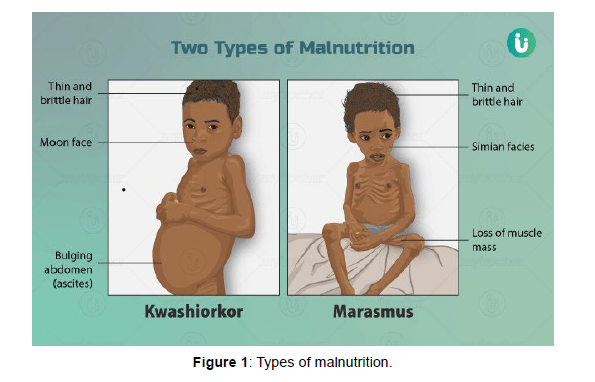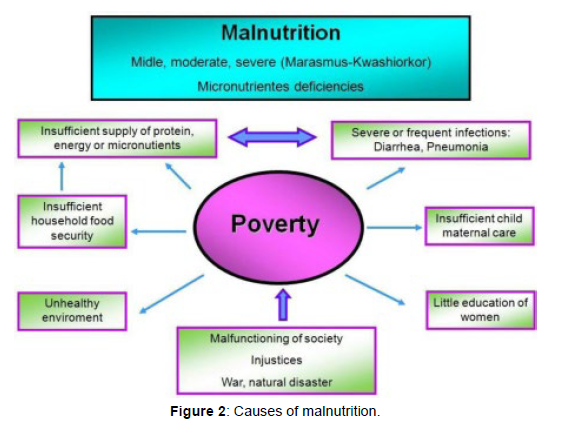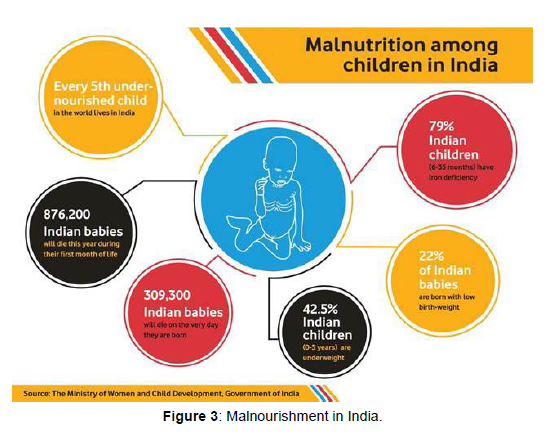Malnutrition: Understanding the Global Crisis and Pursuing Solutions for a Healthier World
Received: 03-Jul-2023 / Manuscript No. JCPHN-23-106823 / Editor assigned: 05-Jul-2023 / PreQC No. JCPHN-23-106823 (PQ) / Reviewed: 19-Jul-2023 / QC No. JCPHN-23-106823 / Revised: 22-Jul-2023 / Manuscript No. JCPHN-23-106823 (R) / Published Date: 29-Jul-2023 DOI: 10.4172/2471-9846.1000437
Abstract
Malnutrition remains a pressing global issue that affects millions of people, particularly in developing countries. It is a complex condition characterized by inadequate intake or absorption of essential nutrients, leading to adverse health outcomes. In this article, we will explore the multifaceted nature of malnutrition, its causes, consequences, and the urgent need for collective action to address this global crisis and promote a healthier world.
Keywords
Malnutrition; Global crisis; Poverty
Introduction
Malnutrition refers to a state of nutritional imbalance, encompassing both undernutrition and over nutrition. Undernutrition occurs when individuals lack essential nutrients, while over nutrition arises from excessive intake of calories and poor diet quality. Both forms of malnutrition have severe health implications and contribute to the burden of disease worldwide [1].
Methodology
Causes and factors contributing to malnutrition
Poverty and limited access to nutritious food are primary contributors to malnutrition. Inadequate financial resources and lack of infrastructure can hinder people's ability to obtain a balanced diet, perpetuating the cycle of malnutrition.
Poor dietary practices
Unbalanced diets lacking essential nutrients, such as vitamins, minerals, and proteins, contribute to malnutrition. Limited diversity in food choices, overconsumption of processed foods, and cultural or social practices can all influence dietary patterns [2, 3].
Health conditions and infections
Underlying health conditions, such as gastrointestinal disorders, can impair nutrient absorption and utilization, leading to malnutrition. Infections, particularly in children, can exacerbate malnutrition by reducing appetite, disrupting nutrient absorption, and increasing nutrient requirements.
Consequences of malnutrition
Malnutrition, particularly during critical periods such as pregnancy and early childhood, can lead to stunted growth, impaired cognitive development, and reduced physical abilities. These long-term consequences hinder individuals' potential and perpetuate cycles of poverty.
Weakened immune system
Malnutrition compromises the immune system, making individuals more susceptible to infections and lengthening recovery periods. This increases the risk of illness, complications, and even mortality, especially among vulnerable populations such as children and the elderly [4, 5].
Increased risk of chronic diseases
Malnutrition contributes to the development of chronic diseases,including cardiovascular diseases, diabetes, and certain types of cancer. Over nutrition, characterized by excessive calorie intake and unhealthy dietary patterns, is closely linked to obesity and its associated health risks (Table 1).
| Type of Malnutrition | Description |
|---|---|
| Undernutrition | 1. Acute Malnutrition (Wasting): Significant weight loss, often accompanied by muscle wasting, caused by inadequate nutrient intake or underlying illness. |
| 2. Chronic Malnutrition (Stunting): Failure to reach optimal height and growth due to prolonged nutrient deficiencies, primarily during early childhood. | |
| 3. Micronutrient Deficiencies: Inadequate intake or absorption of essential vitamins and minerals, leading to specific nutrient deficiencies (e.g., iron, vitamin A, iodine, zinc). | |
| Over nutrition | 1. Overweight: Excessive body weight, usually resulting from an imbalance between calorie intake and energy expenditure. |
| 2. Obesity: A more severe form of overweight characterized by excessive accumulation of body fat associated with various health risks. | |
| 3. Diet-Related Non-communicable Diseases: Conditions like cardiovascular disease, type 2 diabetes, and certain cancers due to long-term consumption of unhealthy, calorie-dense diets. | |
| 4. Malnutrition in the Context of Obesity (Dual Burden): The coexistence of both undernutrition and overweight/obesity within populations or individuals, often observed in transitioning societies. | |
| Other Forms of Malnutrition | 1. Hidden Hunger: Inadequate intake of essential micronutrients, despite sufficient calorie intake, resulting in deficiencies that may not be immediately visible but affect overall health and development. |
| 2. Protein-Energy Malnutrition: Insufficient intake of protein and calories, leading to stunted growth, weakened immunity, and impaired organ function. | |
| 3. Famine-Related Malnutrition: Severe food shortage and widespread malnutrition often associated with prolonged periods of drought, conflict, or other humanitarian crises. | |
| 4. Specific Nutrient Deficiencies: Lack of specific nutrients, such as vitamin C (causing scurvy), vitamin D (leading to rickets), or niacin (resulting in pellagra), leading to distinct health problems associated with the particular deficiency. |
Table 1: Different types of malnutrition and their key characteristics.
Addressing the malnutrition crisis
Promoting agricultural development, improving infrastructure for food storage and transportation, and implementing social safety nets can help address food insecurity and ensure access to nutritious food for vulnerable populations. Empowering communities through nutrition education programs raises awareness about healthy dietary practices, including the importance of balanced meals, breastfeeding, and appropriate infant feeding practices. This fosters long-term behaviour change and promotes healthier lifestyles (Figure 1).
Support for maternal and child health
Investing in comprehensive maternal and child health programs,including prenatal care, breastfeeding support, and early childhood nutrition interventions, can prevent malnutrition and its long-term consequences [6-8].
Collaboration and policy change
Addressing malnutrition requires collaborative efforts involving governments, policymakers, healthcare professionals, and civil society organizations. Policy changes, such as regulating food advertising, implementing nutrition labelling, and promoting sustainable agriculture, are crucial to creating an environment that supports healthier food choices (Table 2).
| Aspect | Statistics |
|---|---|
| Prevalence | 1. Stunting (height-for-age): 37.9% of children under 5 years (NFHS-5, 2019-2020) |
| 2. Wasting (weight-for-height): 17.3% of children under 5 years (NFHS-5, 2019-2020) | |
| 3. Underweight (weight-for-age): 35.8% of children under 5 years (NFHS-5, 2019-2020) | |
| 4. Anemia: 40.5% of children aged 6-59 months (NFHS-5, 2019-2020) | |
| 5. Anemia: 55.3% of women aged 15-49 years (NFHS-5, 2019-2020) | |
| Causes | 1. Inadequate dietary intake |
| 2. Poor access to healthcare and sanitation facilities | |
| 3. Poverty and economic disparities | |
| 4. Lack of awareness about proper nutrition practices | |
| 5. Inadequate breastfeeding and complementary feeding practices | |
| Consequences | 1. Impaired physical and cognitive development |
| 2. Increased susceptibility to infections and diseases | |
| 3. Reduced productivity and economic impact | |
| 4. Higher risk of maternal and child morbidity and mortality | |
| Government Initiatives | 1. Integrated Child Development Services (ICDS) |
| 2. National Nutrition Mission (Poshan Abhiyan) | |
| 3. Mid-Day Meal Scheme | |
| 4. Pradhan Mantri Matru Vandana Yojana (PMMVY) | |
| 5. National Food Security Act (NFSA) |
Table 2: Key statistics and aspects related to malnutrition in India.
Malnutrition remains a global crisis with profound implications for individuals, communities, and nations. By understanding the causes and consequences of malnutrition and implementing comprehensive strategies, we can make significant progress in combating this crisis. Promoting food security, nutrition education, and healthcare interventions, while addressing underlying social and economic factors, can contribute to a healthier world where everyone has access to adequate and nutritious food. It is through collective action and sustained commitment that we can pave the way for a future free from the burdens of malnutrition, ensuring a brighter and healthier future for all [10-13].
Malnutrition remains a pressing global health challenge, affecting millions of individuals across the world. While often associated with undernutrition and hunger, malnutrition encompasses a broader spectrum, including both undernutrition and over nutrition. The consequences of malnutrition are far-reaching, impacting physical and cognitive development, overall health, and economic productivity. In this article, we will delve into the issue of malnutrition, exploring its causes, consequences, and the importance of pursuing sustainable solutions to combat this pervasive problem (Figure 2).
Malnutrition refers to the imbalance between the nutrients an individual needs for optimal health and the nutrients they actually consume. It includes both undernutrition’s, characterized by insufficient intake of essential nutrients, and over nutrition, marked by excessive intake of certain nutrients, often leading to obesity and associated health issues. Limited access to nutritious foods, especially in low-income communities, can result in inadequate diets lacking essential nutrients. Poverty, food insecurity, and unequal distribution of resources contribute to this aspect of malnutrition [14].
Improper feeding practices during the critical stages of early childhood can lead to malnutrition. Lack of exclusive breastfeeding, early introduction of inappropriate complementary foods, and poor feeding practices contribute to stunting, wasting, and micronutrient deficiencies in young children. In today's fast-paced world, processed foods high in unhealthy fats, sugars, and salt have become more accessible and affordable. These dietary patterns, coupled with sedentary lifestyles, contribute to over nutrition, obesity, and diet-related noncommunicable diseases. Malnutrition during early childhood can lead to stunted growth, cognitive impairment, and compromised immune function. Lack of proper nutrition deprives children of the necessary building blocks for healthy development, affecting their longterm potential. Malnutrition weakens the immune system, making individuals more vulnerable to infectious diseases. Undernourished individuals have reduced resistance to infections, leading to higher morbidity and mortality rates, particularly among children and the elderly (Figure 3).
Malnutrition can have long-lasting health consequences. Undernutrition increases the risk of chronic diseases, such as cardiovascular disease, diabetes, and osteoporosis. Over nutrition, on the other hand, contributes to obesity, which is linked to numerous health problems, including heart disease, stroke, and certain cancers. Efforts should focus on ensuring access to a diverse range of affordable, nutritious foods, particularly in underserved communities. This involves supporting local agriculture, promoting sustainable food production, and implementing social safety nets to address food insecurity [15].
Education and awareness campaigns play a crucial role in promoting healthy eating habits and proper nutrition. Targeted interventions can educate individuals on the importance of balanced diets, optimal infant and young child feeding practices, and the risks associated with unhealthy food choices. Investments in healthcare infrastructure, including access to clean water, sanitation, and quality healthcare services, are essential for preventing and treating malnutrition. Health systems need to prioritize screening, early detection, and management of malnutrition, particularly among vulnerable populations. Addressing malnutrition requires multispectral collaboration and partnerships between governments, civil society organizations, private sectors, and international agencies. Collective efforts can facilitate knowledge sharing, resource mobilization, and the development of sustainable solutions [16].
Results
Malnutrition remains a complex and pervasive challenge affecting individuals globally. By understanding its causes, consequences, and pursuing sustainable solutions, we can work towards a healthier future. Efforts to improve access to nutritious foods, promote healthy eating habits, enhance nutrition education, strengthen healthcare systems, and foster collaborations are vital to combat malnutrition in all its forms. Together, we can create a world where individuals have access to adequate nutrition, paving the way for healthier communities, improved well-being, and brighter futures for all.
Malnutrition is a significant global health issue that has been extensively studied and researched. Here are some key findings and statistics related to malnutrition: According to the World Health Organization (WHO), an estimated 149 million children under the age of five worldwide are stunted (short for their age) due to chronic undernutrition. In 2019, it was estimated that 690 million people worldwide were undernourished, with the highest prevalence in Africa and Asia. Undernutrition contributes to approximately 45% of all child deaths globally, primarily due to infectious diseases such as pneumonia, diarrhoea, and malaria.
The prevalence of overweight and obesity has been steadily increasing in both developed and developing countries.
In 2016, over 1.9 billion adults were overweight, of which 650 million were classified as obese.
Over nutrition and obesity are major risk factors for noncommunicable diseases such as cardiovascular diseases, type 2 diabetes, and certain cancers.
Micronutrient deficiencies, also known as hidden hunger, affect a large portion of the global population.
Iron deficiency is the most common nutritional disorder, affecting approximately 1 in 3 people worldwide, with women and children being particularly vulnerable.
Vitamin A deficiency affects an estimated 250 million preschoolage children, leading to increased risk of infectious diseases and visual impairments.
Malnutrition has significant economic consequences, including decreased productivity, increased healthcare costs, and reduced educational attainment.
Discussion
The World Bank estimates that malnutrition costs the global economy billions of dollars annually in lost productivity and healthcare expenses. Malnutrition is a major obstacle to achieving several of the United Nations' SDGs, including eradicating poverty, achieving zero hunger, and ensuring good health and well-being for all. Addressing malnutrition requires a multifaceted approach that includes improving access to nutritious foods, promoting appropriate infant and young child feeding practices, enhancing nutrition education and awareness,strengthening healthcare systems, and addressing social and economic determinants of malnutrition.
Conclusion
It is important to continue investing in research, policies, and interventions to combat malnutrition at all levels, from global initiatives to community-based programs. By addressing malnutrition comprehensively, we can improve health outcomes, enhance quality of life, and contribute to the overall well-being and sustainable development of individuals and communities worldwide.
References
- Brito FMS, Bortoletto Júnior G, Paes JB, Belini UL, Tomazello-Filho M (2020) Technological characterization of particleboards made with sugarcane bagasse and bamboo culm particles. Constr Build Mater 262:120501.
- Aydin I, Demirkir C, Colak S, Colakoglu G (2017) Utilization of bark flours as additive in plywood manufacturing. Eur J Wood Prod 75:63-69.
- Rajeshkumar G, Seshadri SA, Devnani GL, Sanjay MR (2021) Environment friendly, renewable and sustainable poly lactic acid (PLA) based natural fiber reinforced composites-A comprehensive review. J Clean Prod 310:127483.
- Pędzik M, Janiszewska D, Rogoziński T (2021) Alternative lignocellulosic raw materials in particleboard production: A review. Ind Crops Prod 174:114162.
- Haag AP, Maier RM, Combie J (2004) Bacterially derived biopolymers as wood adhesives. Int J Adhes 24:495-502.
- Soubam T, Gupta A, Sharma S (2022) Mechanical property study of plywood bonded with dimethylol dihydroxy ethylene urea crosslinked rice starch-natural rubber latex-based adhesive. Mater Today Proc.
- Derraik JGB (2002) the pollution of the marine environment by plastic debris: a review. Mar Poll Bull 44: 842-852.
- Barnes DKA, Galgani F, Thompson RC, Barlaz M (2009) Accumulation and fragmentation of plastic debris in global environments. Phil Trans R Soc B 364: 1985-1998.
- Thompson RC, Swan SH, Moore CJ, vom Saal FS (2009) our plastic age. Phil Trans R Soc B 364: 1973-1976.
- Avio CG, Gorbi S, Regoli F (2017) Plastics and microplastics in the oceans: from emerging pollutants to emerged threat. Mar Environ Res 128: 2-11.
- Jambeck JR, Geyer R, Wilcox C, Siegler TR, Perryman M, et al. (2015) Plastic waste inputs from land into the ocean. Science 347: 768-771.
- Law KL (2017) Plastics in the marine environment. Annu Rev MarSci 9: 205-229.
- Andrady AL (2011) Microplastics in the marine environment. Mar Poll Bull 62: 1596-1605.
- Cole M, Lindeque P, Halsband C, Galloway TS (2011) Microplastics as contaminants in the marine environment: a review. Mar Poll Bull 62:2588-2597.
- Van Cauwenberghe L, Vanreusel A, Mees J, Janssen CR (2013) Microplastic pollution in deep-sea sediments. Environ Poll 182: 495-499.
- Obbard RW, Sadri S, Wong YQ, Khitun AA, Baker I (2014) Global warming releases microplastic legacy frozen in Arctic Sea ice. Earth's Future 2:315-320.
Citation: Chauhan M (2023) Malnutrition: Understanding the Global Crisis andPursuing Solutions for a Healthier World. J Comm Pub Health Nursing, 9: 437. DOI: 10.4172/2471-9846.1000437
Copyright: © 2023 Chauhan M. This is an open-access article distributed underthe terms of the Creative Commons Attribution License, which permits unrestricteduse, distribution, and reproduction in any medium, provided the original author andsource are credited.
Select your language of interest to view the total content in your interested language
Share This Article
Recommended Journals
Open Access Journals
Article Tools
Article Usage
- Total views: 1962
- [From(publication date): 0-2023 - Oct 27, 2025]
- Breakdown by view type
- HTML page views: 1647
- PDF downloads: 315



